Apple iPhone X adopts facial recognition and OLED screen
Apple has revealed a high-end smartphone with an "edge-to-edge" screen that has no physical home button.
The iPhone X - which is referred to as "ten" - uses a facial recognition system to recognise its owner rather than a fingerprint-based one.
Apple said FaceID can work in the dark by using 30,000 infra-red dots to check an identity, and was harder to fool than its old TouchID system.
It is Apple's most expensive phone yet.
A 64 gigabyte capacity model will cost $999 (£999 in the UK) when it goes on sale on 3 November. A 256GB version will be priced at $1,149 (£1,149 in the UK).
By contrast, Samsung is charging $930 (£869 in the UK) for its new Note 8 phone, which has 64GB of storage.
"The iPhone X is a long-term investment by Apple that sets a template for the next generation of iPhone hardware," commented Geoff Blaber from the CCS Insight consultancy.
"An OLED [organic light-emitting diode] display and the new design is likely to be standard on future iPhone models, but Apple must first tackle the challenge of obtaining sufficient supplies."
Apple said the switch to an OLED display would help the phone produce "true blacks" and more accurate colours than before. LG and Samsung already use similar tech on their handsets.
Prior to the launch, Apple's most expensive phone was an iPhone 7 Plus that cost $969 (£919 in the UK).
One expert commented that Apple's ability to get consumers to spend more on its smartphones than rivals' was "legendary".
"There may be an element of high pricing to constrain demand and make things match up with how many they can produce," said Neil Mawston from Strategy Analytics.
"But I suspect Apple always had a $1,000 iPhone in mind - we had seen the price creep up year after year, and there's a lot of pressure from shareholders for the company to hit a $1tn valuation.
"Bumping up the prices on their number one product is one way of doing that."
Facial recognition
Apple acknowledged that users might have concerns about using facial recognition to verify purchases via Apple Pay or to access their device.
But it claimed that while there was a one-in-50,000 chance that TouchID could be unlocked by a random stranger, the odds rose to one-in-one-million with FaceID.
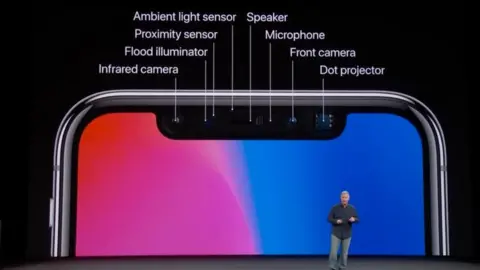 Apple
AppleNevertheless, one expert said users might still be concerned the handset had no fingerprint sensor as an alternative.
"This is the steepest hurdle that they have," commented Carolina Milanesi from market research firm Creative Strategies.
"A lot of consumers will be a little bit reluctant to use facial recognition as an ID system until Apple has proven that it is safe and works all the time.
"In the eyes of consumers TouchID wasn't broken - so they may ask why Apple is trying to fix it."
Other features announced about the handset included:
- its 5.8in (14.7cm) screen has 458 pixels per inch, making it the firm's most detailed phone display to date. To mark this it has been branded "super retina"
- the lack of a home button is dealt with by requiring users to swipe up to access its apps, and to press a side button to summon its virtual assistant Siri
- portrait mode - in which the camera blurs a photo's background - and a relighting tool can be used on pictures taken by both the front and rear cameras
- it has two hours more battery life than the iPhone 7

Analysis
 Reuters
ReutersBy Dave Lee, North America technology correspondent
It's the big(ger) leap that iPhone fans - and Wall Street - had been demanding.
The iPhone X brings together many features we'd been expecting - such as FaceID for unlocking the phone, and animated emojis - animojis - that look fun to play with, if not a killer feature that will have people running to stores.
All this won't come cheap: at $999+ it's the most expensive iPhone to date.
Apple is often accused of being slow to new tech, and I think that criticism will continue.
Wireless charging comes years after Samsung first introduced it, for example, and the overall look of the phone - which no longer has the iconic home button - looks strikingly similar to the latest Samsung Galaxy Note.
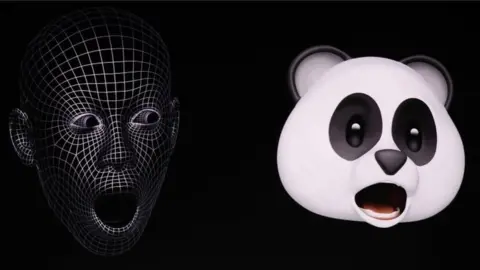 Reuters
ReutersThe phone was unveiled in the new Steve Jobs Theater, a purpose-built venue for such launches.
A beautiful, comfy building, with marble everywhere, it sits alongside Apple's striking new spaceship campus. This is the house that iPhone built, with a decade of phenomenal success.
Does iPhone X herald another great era? The audience here cheered, but didn't stand, with applause. I'm reserving my judgement until I've tried it.

The iPhone X also adds support for wireless charging.
"Apple chose Qi wireless charging," noted Ian Fogg, from the IHS Markit consultancy.
"It was the right decision to use a standard because Apple users will benefit from widely available charge pads."
The feature was also introduced to the new iPhone 8 and iPhone 8 Plus models, which were introduced earlier at the event.
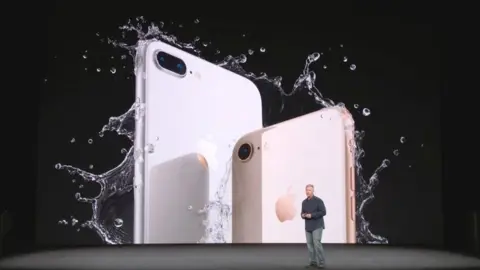 APple
APpleThe lower-end 4.7in and 5.5in devices are distinguished from their predecessors by having:
- glass rather than metal backs
- faster processors
- improved camera sensors that help them operate in low light
- stereo speakers that are 25% louder than before
The iPhone 8 ranges from $699 to $849 and the iPhone 8 Plus from $799 to $949.
They will cost the same amounts in Sterling and go on sale on 22 September.
Mixed reality
The new models coincide with the release of iOS 11 - the latest version of Apple's mobile operating system.
It introduces ARKit - software development tools that make it easier for developers to add augmented reality features to their apps, in which graphics are mixed together with real-world views.
Marketing chief Phil Schiller showed off one app that - if used by spectators at a sports stadium - would show real-time stats hovering over the live action.
Another demo involved the Machines, a multiplayer robot-battle game that can be played over views of close-by table tops and other surfaces.
The facility will not work on the iPhone 6 or older devices, so may provide a means to convince owners of ageing Apple kit to upgrade.
"When Apple first introduced the iPhone users were unsure about how touchscreens would benefit them, but now we know that they're a great way to use a device," said Brian Blau, a tech industry analyst at Gartner.
"The same thing will happen with augmented reality - it's as important as touch, if not more.
"Developers have new opportunities and I think they will embrace them, but just as with touch it took them years to perfect those experiences, I also think that will also happen with AR."
Apple also unveiled a version of its smartwatch with its own 4G link.
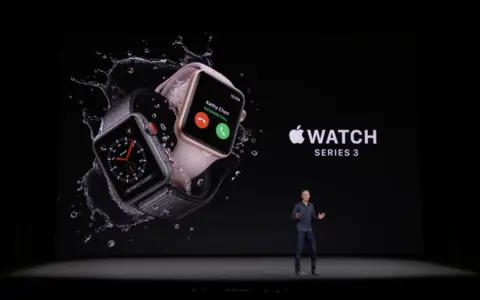
The innovation means that the Watch Series 3 can receive phone calls, access internet services and stream music without being linked to an iPhone. Users will, however, face an additional monthly charge for the benefit.
Apple recently overtook Fitbit to become the world's joint-top wearable tech-maker alongside Xiaomi, according to one study.
Other companies - including LG and Samsung - have previously sold smartwatches with in-built cellular capabilities, but battery-life restrictions and other issues limited interest.
"Apple's ability in the past to generate new markets when others thought they were dead is legendary," commented Mr Mawston.
"For people like joggers, runners and cyclists who possibly want to do hardcore sports outdoors without carrying two devices, an LTE Apple Watch could be something of a blessing."
The latest version of the Watch's operating system - which will also be available to earlier models - will include new heart monitor functions.
It will warn owners if their heart rate becomes elevated when they are not active or if its rhythm becomes irregular, to flag the possibility of disease.
The 4G Apple Watch will cost $399 (£300) and be released on 22 September.

4K movies
Apple also announced a fresh version of its TV set-top box, which now supports 4K video and high dynamic range (HDR) content.
In one of the few details not to have leaked in advance, Apple revealed it had struck a deal with several of the major movie studios to ensure that films in the higher-resolution, richer-colour formats would not cost more than their high-definition (HD) equivalents.
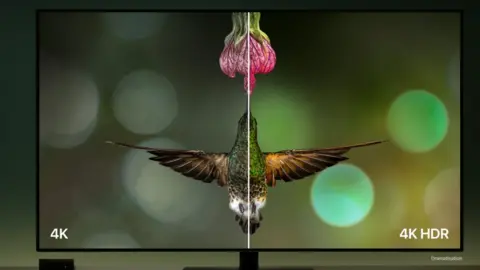 Apple
AppleUsers' existing iTunes movie libraries will also be upgraded without charge.
HDR 4K movies have already been available to rent or buy from services including Amazon, but they tended to be sold at much higher prices than lower-quality formats.
